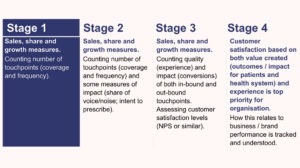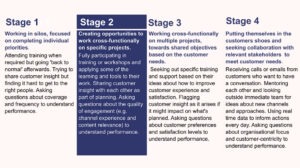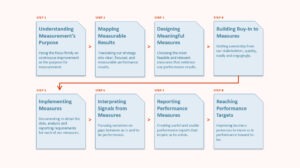Customer engagement – a phrase that’s been used for years within Life Sciences. And whilst the essence of what customer engagement is may be a relative constant, defining what it means, what it looks like (when its being achieved) and the vision for it will differ for every organisation.
Once an organisation understands and is committed to customer engagement, it is fundamental that the right infrastructure is there to enable it – one crucial element being how it is measured. This article shares ideas on how to do this effectively.
The relationship between measurement and customer engagement
Forbes cite that ineffective performance measurement is one of the most acknowledged problems as to why up to 90% of strategies fail.
HBR reports that whilst strategies may be well meaning and say that ‘we put the customer and patient first’, it is well known that people tend to the metrics they are presented with because they tend to be more tangible than the strategy (especially if incentives are too closely aligned to these).
Ultimately measures drive behaviour. So, if a strategy is focused on customer engagement the measures must be there to back it up. For example: if the focus is on growth targets that is where attention will fall versus engagement – ultimately creating a tension and the failure to fulfil the overarching strategy.
The status quo when it comes to measuring customer engagement
Rubica’s Customer Engagement (CE) diagnostic’ has found a strong positive correlation between the levels of maturity for ‘How we measure success’ (A) and the ‘Common Behaviours’ (B) associated to customer engagement’. I.e. when levels of maturity were high for (A), they tended to for (B) and vice versa.
An example
We recently worked with an organisation to understand how leaders across 15 EU markets and 3 therapeutic areas rated their level of maturity across Rubica’s customer engagement (CE) scale. Here are some of the highlights of what we found…
- A large majority (69%) of markets said their level of CE maturity was low when it comes to ‘HOW WE MEASURE SUCCESS’ (A):

- A majority (57%) of markets said their level of CE maturity for ‘COMMON BEHAVIOURS’ (B) was also low:

Fundamentally our findings found that whilst customer engagement was something that was espoused, behaviours that would enable its fulfilment were still in their infancy.
Challenging and changing the status quo when measuring customer engagement
Unfortunately measures alone won’t result in successful customer engagement. But we need good measures so that people know the results that matter and what needs to be improved to get closer to optimal customer engagement. A good measurement process is the starting point for generating good measures. But we’ll only get the right behaviour when the entire measurement process supports the right behaviour.
At Rubica we do this using the 8-step PuMP methodology (Fig.1) which does measurement in a very specific way so it supports people to use measures to improve organisational performance, holistically. Some of the important techniques PuMP uses include:
- Accountability for KPIs is defined as monitoring, interpreting and responding to the KPI, not hitting targets
- KPIs are developed by the people who will use them to improve performance
- No KPI is selected without deliberate consideration of its unintended consequences
- Every KPI is linked to related KPIs, to ensure they can all be used to get an holistic understanding of organisational performance
- We use KPIs to help us continually improve our processes to reach for targets, not to hit them.
Fig. 1

To continue reading and for practical ideas on where to start with measuring customer engagement effectively, download our guide here.
 Mark Fisher -
Mark Fisher - 



